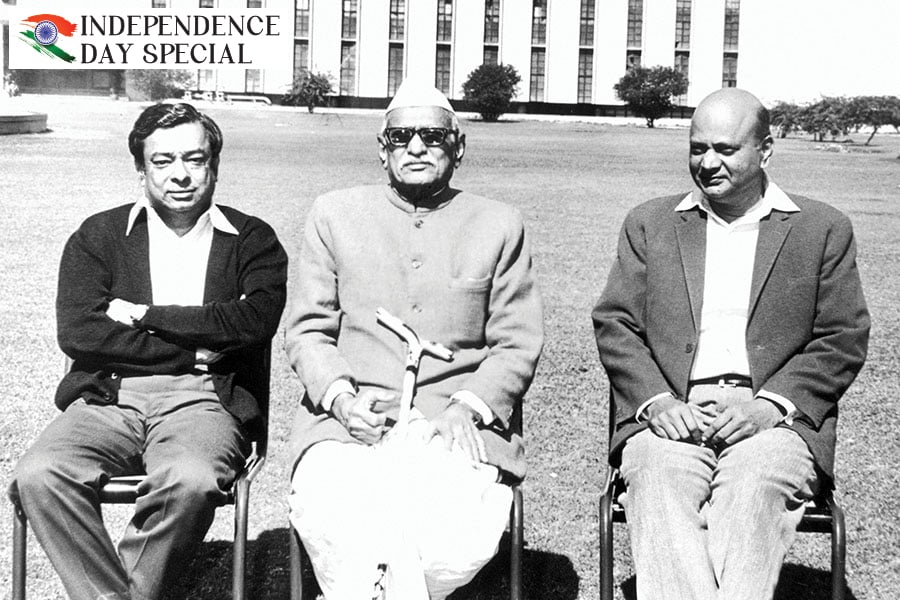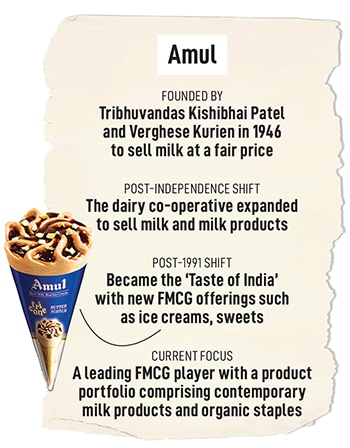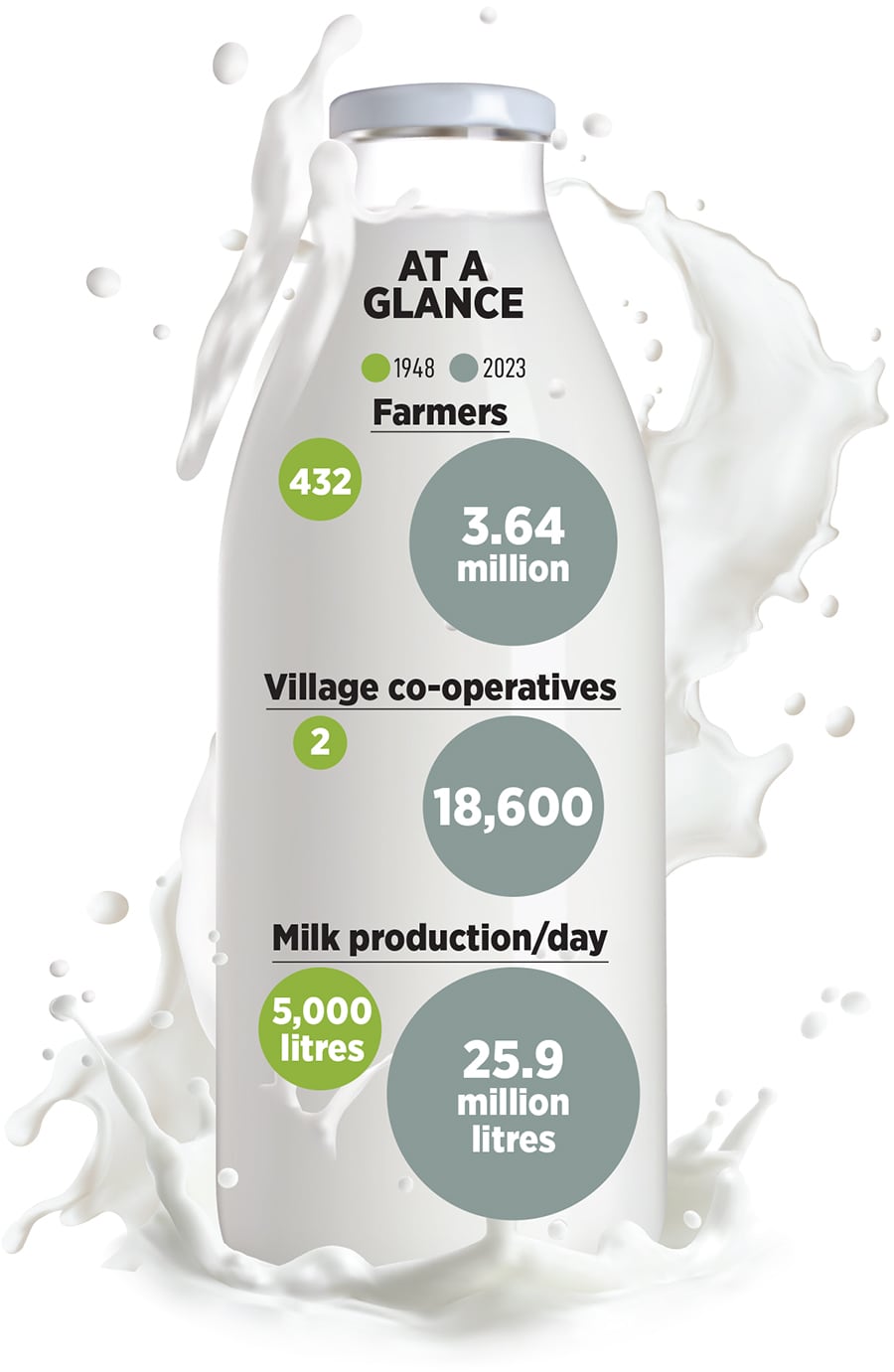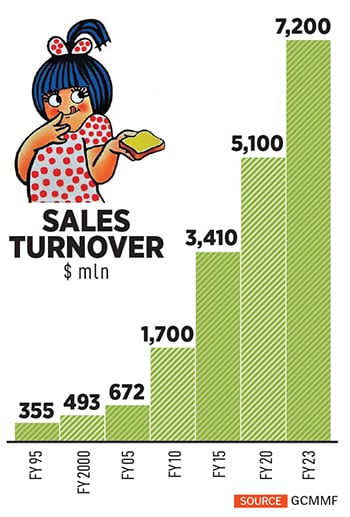Why Amul is the ageless FMCG giant
How Amul, the world's largest dairy cooperative, became synonymous with 'swadeshi' pride
 Verghese Kurien (left) and HM Dalaya with Tribhuvandas Patel (centre), the founder-chairman of Amul
Verghese Kurien (left) and HM Dalaya with Tribhuvandas Patel (centre), the founder-chairman of Amul
A patriotic call for the social and economic development of downtrodden farmers stirred a historic movement and laid the foundation of a leading FMCG giant, Amul, which is also the world’s largest dairy cooperative.
Eventually, the KDMPUL won and the farmers managed to break the shackles of poverty. Led by Patel, in about two years, the milk cooperative grew from a handful of farmers to over 430 farmers, and daily milk production rose from 250 litres to 5,000 litres.
 Around three years later, Patel roped in Verghese Kurien, a 28-year-old engineer who had returned to India after a brief stint in the US, to provide technical expertise. Kurien hesitantly agreed to stay in Anand for a few days to help with the dairy equipment. But the welfare of the milk cooperative soon became Kurien’s life purpose and he ended up staying in Anand until he died at the age of 91 years.
Around three years later, Patel roped in Verghese Kurien, a 28-year-old engineer who had returned to India after a brief stint in the US, to provide technical expertise. Kurien hesitantly agreed to stay in Anand for a few days to help with the dairy equipment. But the welfare of the milk cooperative soon became Kurien’s life purpose and he ended up staying in Anand until he died at the age of 91 years.Post-independence, the milk cooperative became synonymous with swadeshi pride as it rapidly expanded in size and turnover. In the course of six decades, by empowering farmers at the grassroots, Kurien adopted cutting-edge technology and instituted robust governance structures to scale-up the cooperative movement across the country. In fact, the exemplary success of KDMPUL inspired the ‘Operation Flood’ program in July 1970.
Its architect, Kurien, scripted one of the country’s most glorious chapters in history. As the Father of the White Revolution, he reimagined supply chain logistics for a perishable commodity like milk, and paved the way for India to become the world’s largest milk producer by uplifting the poor.
RS Sodhi, president, Indian Dairy Association, worked at Amul for over 40 years and considers Verghese Kurien to be his mentor: “Dr Kurien was working for the benefit of farmers to provide them the best returns. Big multinationals work for their shareholders and the bottom line. So, the objectives are different.”
Also read: Why Amul is investing heavily in international cricket teams like USA Cricket
The Taste of India
In less than ten years of India’s independence from imperial rule, the milk cooperative spread its wings across hundreds of villages in Gujarat. As production increased, the milk cooperative realised the need to expand its offerings, and advertise its range of products, to cater to a bigger market. So, KDCMPUL registered its brand name and ‘Amul’ was born in 1957. To reduce the country’s dependency on imported milk powder for manufacturing butter, condensed milk, and baby food, Kurien’s team led by HM Dalaya—much to the surprise of MNCs—devised a path-breaking and indigenous technological process to convert buffalo milk into powder to help the nation become self-reliant for milk products.
To reduce the country’s dependency on imported milk powder for manufacturing butter, condensed milk, and baby food, Kurien’s team led by HM Dalaya—much to the surprise of MNCs—devised a path-breaking and indigenous technological process to convert buffalo milk into powder to help the nation become self-reliant for milk products.This breakthrough opened doors for the milk cooperative to foray into new categories and launch variants—cheese spread, shrikhand, condensed milk, chocolates, ice cream, traditional sweets such as gulab jamun—to turn the tables on MNCs such as Nestle and Unilever.
The milk farmers’ movement became a national phenomenon. By 1973, the Gujarat Co-operative Milk Marketing Federation (GCMMF) was formed to house the growing product portfolio of the brand while institutionalising systems and processes to ensure fair returns to the milk farmers. As per the framework, 80-85 percent of every rupee paid by a consumer goes back to the 3.6 million cooperative members.
Amul has become a trusted household name for the young and the old. “There is consistency in the product recipes which have not changed in the last 65 years,” Sodhi, the former managing director of Amul, told Forbes India in an earlier interview. “Once you keep farmers happy and consumers happy, your business will automatically grow, succeed, and become ageless.”
 There is consistency in the advertising campaign as well. Since 1966, the iconic ‘Amul girl’ and the tagline have won the hearts of people across generations with the topical cartoon illustrations. Incidentally, it is the world’s longest running advertising campaign and the ad-spend is about 1 percent of total sales.
There is consistency in the advertising campaign as well. Since 1966, the iconic ‘Amul girl’ and the tagline have won the hearts of people across generations with the topical cartoon illustrations. Incidentally, it is the world’s longest running advertising campaign and the ad-spend is about 1 percent of total sales.The Indian cooperative giant reported a total turnover of Rs72,000 crore in FY23. Its management team is hopeful of achieving its FY26 revenue target of Rs1 lakh crore. The dairy behemoth recently partnered with Michigan Milk Producers Association (a 100-year-old local cooperative body) to sell fresh milk and other products in the US.
GCMMF is also evaluating strategies to grow its organic foods business. It opened its first exclusive organic store in Delhi two years ago to sell staples such as cereals and pulses. It plans to open 100 new stores as it seeks to reportedly market sugar, tea, jaggery, among other organic food items even as it continues to tap into the evolving preferences of Gen Z.
At a time when India is facing a challenging job scenario for blue-collar workers, alleged exploitation of gig workers by VC-backed new-age companies, and a widening economic divide between the haves and the have-nots; Kurien’s message at Amul’s 25th annual general meeting in June 1999 holds significance: “The freedom struggle maybe over… but the struggle for the well-being of the have-nots is far from over. Are we prepared for this freedom struggle that lies ahead? I fear that only cooperatives are prepared to wage the real fight of independence.”
(This story appears in the 23 August, 2024 issue of Forbes India. To visit our Archives, click here.)


















